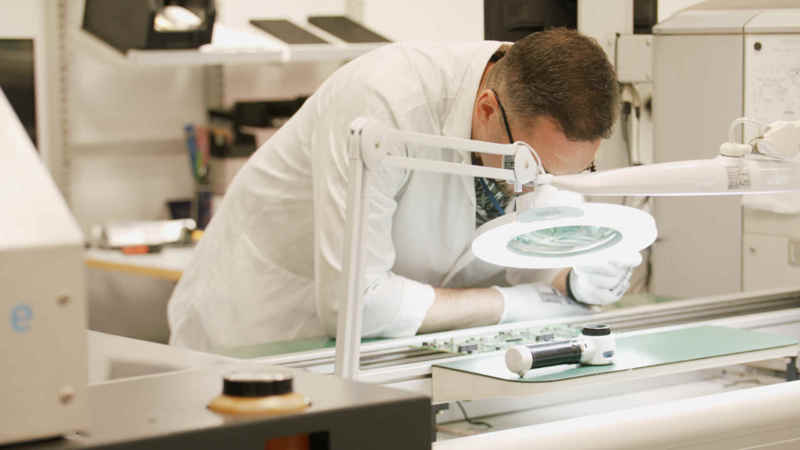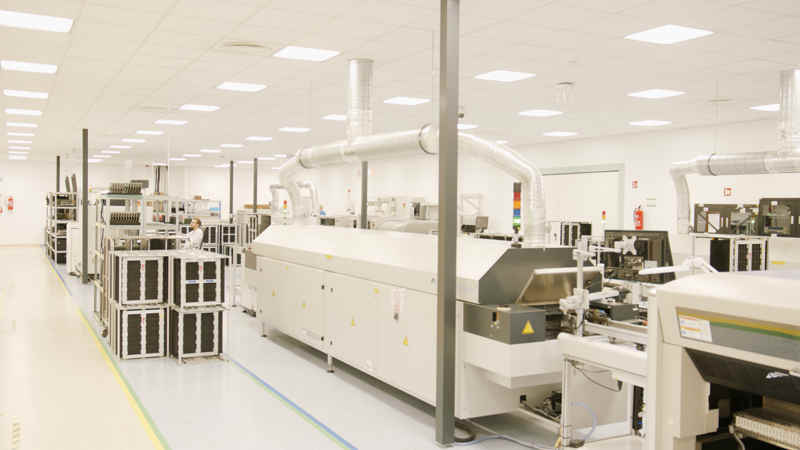SMT assembly process. Step by step through the stages of SMT assembly
Contract electronics assembly including SMT and THT assembly is the key element in the functioning of companies specializing in producing electronics on demand, so-called #EMS companies: Electronic Manufacturing Services. Surface Mount Technology (SMT) is a modern method of assembling electronic components on Printed Circuit Boards (PCBs). In comparison with the traditional through-hole assembly method (THT), SMT is more beneficial because it enables higher efficiency, mounting of smaller components, or better quality of connections.
Differences between SMD and SMT –terminology explained
Surface Mount Technology (SMT) is a technique for assembling electronic components on PCB. Components or electronic devices, so-called Surface Mounted Devices (SMD), made for SMT assembly are characterized by compact dimensions or flat enclosures. At the same time, they have big collar-shaped soldering terminals at the ends of the enclosures. In that quality, electronic SMD components are perfect for assembling on PCBs. The most significant advantage of SMD components is space saving which enables the production of more compact and lightweight devices. Additionally, SMT assembly is automatic which speeds up the production process and lowers its cost.
SMT (Surface Mount Technology) is a technology for assembling electronic components on the surface of a PCB without the need for delaying them through holes. In comparison to the through hole assembly method (THT) SMT is based on placing the components directly on the surface of the PCB which enables reaching higher density of assembly, as well as, better electronic achievements.

How the process of surface mounting works?
Major elements in the SMT assembly process are:
- Soldering paste – used for ensuring components’ adherence to the surface of the PCB and for creating electrical and mechanical connections
- Soldering Paste Inspection (SPI)
- Assembling machines – used for precise mounting of components on the PCB
- Soldering oven – used for melting the soldering paste and strengthening the adhesion between the components and PCB
- Quality control – after the PCB leaves the oven quality control is performed to check the correctness of assembly and the quality of connections – Automatic Optical Inspection (AOI)
- Mounting of additional components – if additional components need to be mounted using the THT method it is the next step after SMT assembly
- Functional testing – the final product is tested to make sure it fulfills the design requirements
To sum up, the SMT assembly process starts with preparing the PCB on which the components will be mounted. The PCB is covered with a special soldering paste which is a part of the soldering process. Such paste ensures proper adhesion of the components to the surface of the PCB. Next, using assembly machines components are precisely placed on the PCB. Finally, the PCB goes through the soldering oven which melts the soldering paste strengthening the electrical and mechanical connections.
SMT assembly features: advantages and disadvantages
SMT assembly gives a lot of advantages for electronics manufacturers such as:
- Higher assembly density – due to the smaller sizes of SMT components it is possible to place more elements on the PCB surface which enables downsizing the final device
- Bigger cost effectiveness – automatization of SMT assembly enables reaching higher production efficiency while achieving lower production costs
- Quality upgrade – more precise machines and quality control at every stage of production guarantee better quality of connections and fewer mistakes
- Better electrical efficiency – smaller sizes of components and shorter connecting paths result in better electrical parameters, e.g.: faster transmissions or resilience to interferences
Despite many advantages, SMT assembly creates several challenges and limitations, such as:
- High investment cost – purchasing and maintaining SMT assembly machines can be costly, especially for small or medium-sized companies
- Difficulties in repairs – due to the small size of components and their layout close to each other on the PCB repairing SMT-assembled devices may be more difficult than fixing THT-mounted boards
- Thermal load-related problems – during the soldering process SMT components are exposed to high temperatures which may lead to thermal damages, especially in the context of sensitive components
- Logistics and components management – due to the diversity of components and their small sizes it is necessary to manage the warehouse and SMT production precisely to avoid errors and delays

SMT assembly process
SMT assembly offers many advantages, e.g.: higher assembly density, cost-effectiveness, or better quality. Nevertheless, SMT assembly also presents various challenges, e.g.: high investment costs, difficulties in repairs, or logistics management.
Among the advantages of SMT assembly, most of all, downsizing the devices can be enumerated. Due to smaller component sizes and the possibility to assemble them on both sides of the PCB, devices produced using SMT are smaller and lighter when compared to their THT-produced equivalents. Additionally, SMT allows increasing assembly density which results in higher efficiency and better electric parameters of the devices.
For OEM manufacturers the process of production is only a means of achieving their goal which is introducing and selling the products. Due to that, moving the responsibility to an EMS provider seems to be the best option. Complex EMS partner offers resources, equipment, tools, procedures, and experience that allows OEMs to concentrate on designing and developing their services
To sum up, SMT assembly is a modern and effective method of assembling electronic components that enables the downsizing of devices while upgrading their efficiency and quality of connections. In the future, we may expect further development of this technology and the introduction of innovative solutions that will ease and speed up the assembly process even more




